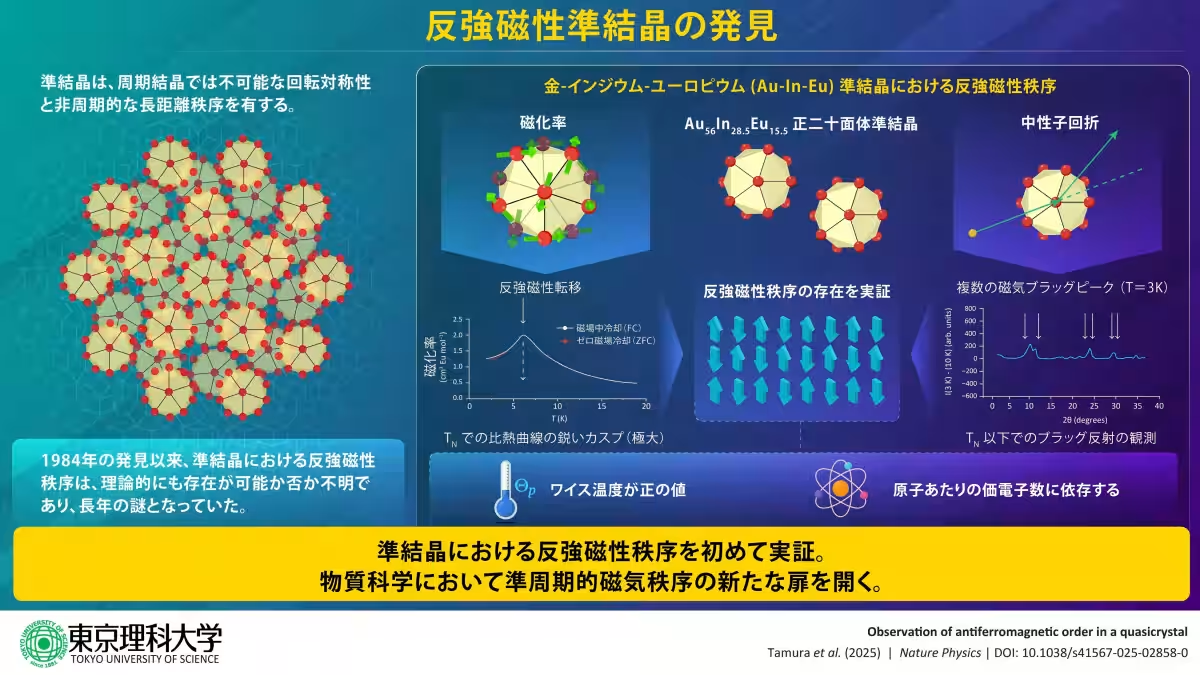

First Evidence of Antiferromagnetic Order in Quasicrystals Unveiled!
Uncovering Antiferromagnetic Order in Quasicrystals
In a remarkable breakthrough, researchers have confirmed the existence of antiferromagnetic order in the quasicrystal Au56In28.5Eu15.5, resolving a long-standing mystery in the field of condensed matter physics. For decades, the presence of long-range antiferromagnetic order in quasicrystals had been a topic of skepticism, leaving many questions unanswered. Now, a collaborative effort spearheaded by Professor Ryuji Tamura from Tokyo University of Science and Professor Taku Sato from Tohoku University has successfully demonstrated that this unique quasicrystal exhibits antiferromagnetic properties.
This study holds significant implications, not just in understanding the intrinsic characteristics of quasiperiodic magnetic order but also for potentially revolutionizing applications in spintronics and other advanced technologies. The findings are detailed in a paper published in Nature Physics on April 11, 2025.
Research Overview
The research team, which also included scholars from the Australian Nuclear Science and Technology Organisation, used advanced techniques such as powder X-ray diffraction and powder neutron diffraction to delve into the structural and magnetic attributes of Au56In28.5Eu15.5. Distinctive for its lack of periodicity, the quasicrystal forms a regular arrangement of atoms, making it a unique material within the study of solid-state physics.
Following the discovery of ferromagnetic quasicrystals by the same research group in 2021, the inquiry into antiferromagnetic quasicrystals remained uncharted territory. The established theoretical foundation surrounding the feasibility of antiferromagnetic order in such materials was still unclear, making the team's pursuit of tangible evidence a challenging endeavor.
The comprehensive analysis from the research indicated a clear antiferromagnetic transition at a Néel temperature of 6.5 Kelvin, where sharp magnetic characteristics were noted. Below this temperature, a metamagnetic transition was observed, underscoring the legitimacy of an antiferromagnetic transition occurring within Au56In28.5Eu15.5.
Additionally, the powder neutron diffraction results showcased magnetic Bragg reflections below the Néel temperature, further validating the existence of the antiferromagnetic order in this quasicrystal.
Background of the Research
The initial discovery of quasicrystals traces back to 1984 by Dan Shechtman at the Technion – Israel Institute of Technology, which awarded him the Nobel Prize in Chemistry in 2011. Quasicrystals are notable for their rotational symmetries that extend beyond the conventional three-dimensional periodic structures, exhibiting unique magnetic, thermal, and electrical properties.
Previously, the lack of evidence for long-range magnetic order in quasicrystals posed an ongoing challenge in the realm of material science. Many known magnetic quasicrystals displayed spin-glass behavior without confirming any long-range magnetic order. The prior work of the research team, showcasing the discovery of ferromagnetic properties in certain types of quasicrystals, had already ignited significant interest and opened new avenues for exploration in this emerging scientific discipline.
For successful realization of this novel antiferromagnetic quasicrystal, the research team took on the challenge of experimentally proving its magnetic order—an endeavor that has now culminated in groundbreaking results.
Detailed Findings
The crystal structure and magnetic characteristics of Au56In28.5Eu15.5 were thoroughly evaluated through temperature-dependent measurements of magnetization. The presence of Eu ions in a divalent state (Eu2+) suggested a lack of orbital angular momentum, which indicated strong ferromagnetic interactions within the material as indicated by a positive Weiss temperature (θ = 3.41 K).
At the lowest measured temperature of 0.4 K, the magnetization reached 7 μB/Eu, confirming alignment with theoretical predictions for Eu2+. Under high magnetic fields, saturation of magnetization was observed, and evidence of a metamagnetic transition surfaced, further endorsing the notion of antiferromagnetic behavior.
The culmination of magnetic Bragg peaks at T = 3 K reaffirmed the anticipated magnetic order, revealing a substantial increase in peak intensity at and below the Néel temperature, thus corroborating the existence of long-range antiferromagnetic order in this quasicrystal.
Professor Ryuji Tamura commented on the implications of this discovery: “Since the inception of periodic crystals, antiferromagnetic order was understood to be unique to periodic structures. The identification of antiferromagnetic order within a quasicrystal marks a pivotal revelation in materials science, ushering in a new research area. We anticipate that the exotic magnetic responses of these antiferromagnetic quasicrystals may considerably impact the fields of spintronics and magnetic refrigeration.

Topics Other)










【About Using Articles】
You can freely use the title and article content by linking to the page where the article is posted.
※ Images cannot be used.
【About Links】
Links are free to use.